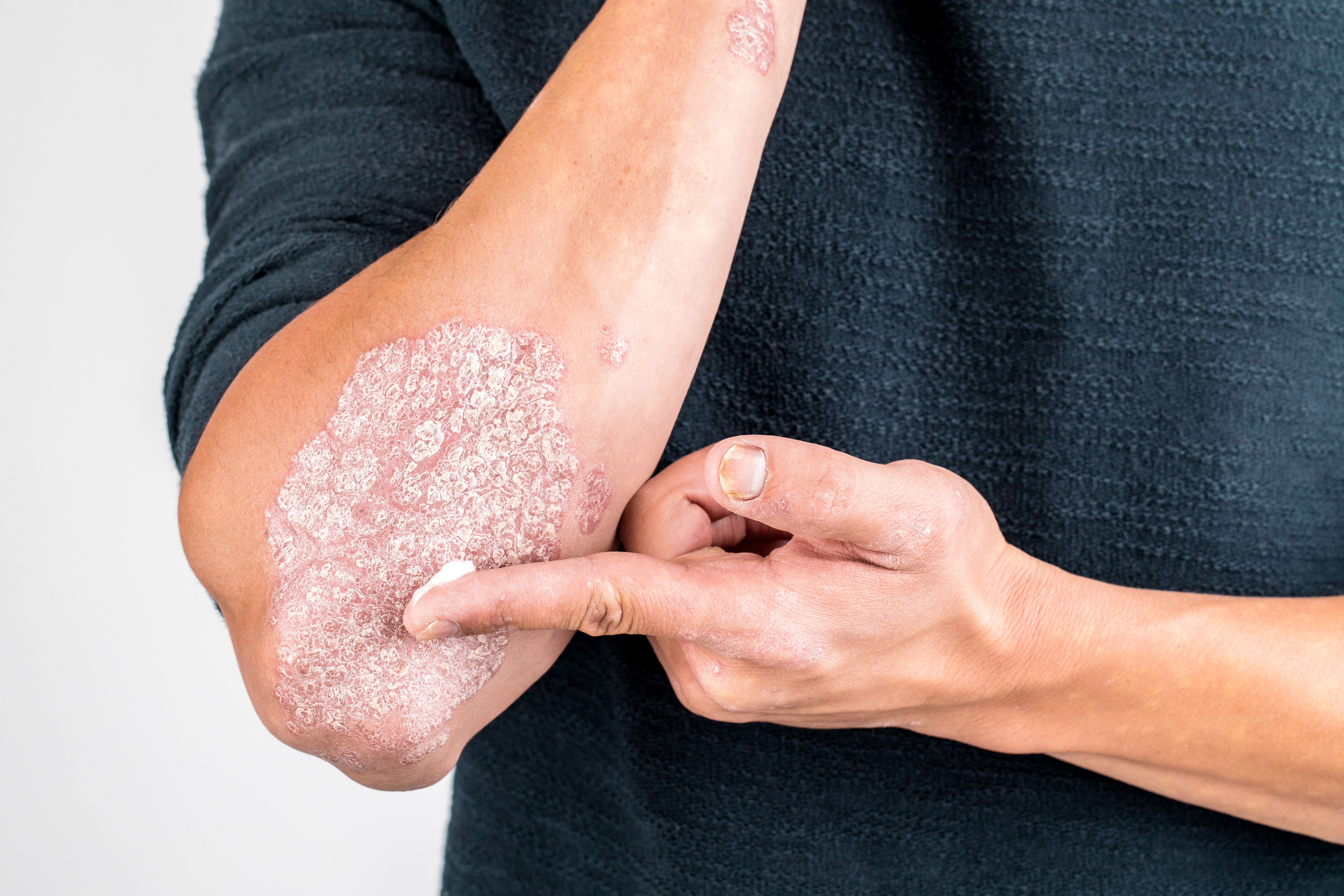- Acne
- Actinic Keratosis
- Aesthetics
- Alopecia
- Atopic Dermatitis
- Buy-and-Bill
- COVID-19
- Case-Based Roundtable
- Chronic Hand Eczema
- Chronic Spontaneous Urticaria
- Drug Watch
- Eczema
- General Dermatology
- Hidradenitis Suppurativa
- Melasma
- NP and PA
- Pediatric Dermatology
- Pigmentary Disorders
- Practice Management
- Precision Medicine and Biologics
- Prurigo Nodularis
- Psoriasis
- Psoriatic Arthritis
- Rare Disease
- Rosacea
- Skin Cancer
- Vitiligo
- Wound Care
Article
Off-label systemic immunomodulators useful for various indications
Author(s):
Although many systemic immunomodulators are approved for psoriasis, their mechanisms of action suggest they have utility in indications ranging from atopic dermatitis (AD) to chronic urticaria. Understanding a systemic immunomodulator’s mechanism of action provides a theoretical basis for uses beyond its labeled indication.
Denver - Although many systemic immunomodulators are approved for psoriasis, their mechanisms of action suggest they have utility in indications ranging from atopic dermatitis (AD) to chronic urticaria, according to an expert.
Understanding a systemic immunomodulator’s mechanism of action provides a theoretical basis for uses beyond its labeled indication, says Neal Bhatia, M.D., a dermatologist in private practice in Long Beach, California, and an associate professor of dermatology at the Harbor University of California Los Angeles Medical Center.
“Apremilast will be marketed for psoriatic arthritis, but its utility in discoid lupus and atopic dermatitis could be substantial,” he says.
RELATED: Gene helps confirm existence of psoriatic arthritis
Improving AD severity
Case reports in AD show that apremilast reduces pruritus and disease severity and helps maintain disease control, he says.
Apremilast inhibits phosphodiesterase-4 (PDE4), which exerts its impact upstream of proinflammatory cytokines including tumor necrosis factor alpha (TNF-alpha) and interleukin (IL)-17a, Dr. Bhatia says.
“In terms of the Th1 profile in psoriasis, if you slow the progression that produces those cytokines and proteins, you can reduce inflammation,” he says.
Along with impacting the expression and actions of cyclic adenosine monophosphate (cAMP), protein kinase A and nuclear factor (NF)-kB, he adds, “Apremilast works on pathways that are much broader and can encompass the Th2 side of inflammation, which was shown in a 16-patient pilot study involving AD.1”
RELATED: Study: CME improves psoriasis care
In this study, patients who took 20mg doses of apremilast twice daily achieved significant reductions in baseline pruritus scores (p=0.02) and the Dermatology Life Quality Index (DLQI; p=0.003) at three months. Patients who took twice-daily 30mg doses achieved significant reductions in DLQI (p=0.01) and Eczema Area and Severity Index (EASI; p=0.008) scores at three months. At six months, investigators observed significant reductions in DLQI, EASI and visual analog scores.
“In AD, we need the fire not only to be put out, but also kept out. That’s where the sustained anti-inflammatory activity of apremilast can help,” Dr. Bhatia says. As eczema shifts from acute to chronic, the Th profile shifts. Initially, “Th2 predominates. Then, as lymphocytes come in and the disease becomes expressed, there is more Th1 immunity later on. So it’s important to catch the disease early. And apremilast has shown it has that potential because it changes the immune makeup early in the disease. AD is a good example of an off-label application that might skyrocket use of apremilast.”
Use in lichen planus
A 10-patient study in lichen planus (LP) showed that twice-daily apremilast doses of 20 mg for 12 weeks, followed by a four-week holiday, produced a two-grade improvement in 30% of patients.2
“We probably won’t see a drug studied for LP because it’s not worth the return on investment,” Dr. Bhatia says. “But again, it’s a matter of taking the drug’s mechanism and applying it to how LP develops.”
RELATED: Oral options not keeping up with biologics
Additionally, The predominance explains why lichen simplex chronicus lesions resemble those of psoriasis. “Lichen simplex chronicus doesn’t have the same morphology as psoriasis, but many of the changes have the same immune profile,” he says.
Long-term use
Apremilast’s safety profile provides many opportunities for long-term use, according to Dr. Bhatia. “In the psoriasis studies, long-term and organ toxicity has been shown to be very minimal,” he says. “As in biologics, you want to keep your finger on the pulse of patients’ liver function, kidney function, and blood count.”
Regarding omalizumab, Dr. Bhatia says, the potential to extend its indication from asthma to chronic urticaria shows promise. In the latter area, a pioneering study highlights omalizumab’s inhibitory effect on mast cells, Fc-epsilon R1 receptors, and overall progression of chronic urticaria lesions.3
More recently, a phase 3 study showed a clear dose response, with patients who received three 300mg subcutaneous injections spaced four weeks apart achieving the greatest reduction in itch severity scores.4 As such, he says, omalizumab might fill the gap in treatments for chronic urticaria.
RELATED: Secukinumab approved for psoriasis
“We have antihistamines and topical anesthetics, which are essentially bandages. We need something that’s much more of a remedy. Omalizumab may serve that purpose by providing, if not a cure, a sustained impact on disease progression,” Dr. Bhatia says.
Somewhat similarly, he says, mycophenolate mofetil appears effective for new indications including urticaria5, morphea, and progressive systemic sclerosis6, Dr. Bhatia says.
“Those are good applications where you need safe, long-term immunosuppression and control that’s more specific - whether it be against lymphocytes or dendritic cells,” he says.
However, “Mycophenolate is associated with high expense, and people think of it as a tertiary drug. Also, it doesn’t fit into chemotherapy or the immunosuppressant category.” These stigmas account for its underuse by dermatologists.
RELATED: Researchers isolate psoriasis triggering proteins
“But if you think in terms of where we use steroids and cyclosporin, they may be quick fixes, whereas mycophenolate can bridge the gap of what we lost with the concerns over azathioprine [long-term toxicity], Dr. Bhatia says.
Finally, he says, tofacitinib and ruxolitinib are oral inhibitors of Janus activated kinase and signal transducer and activator of transcription proteins (JAK-STAT). These drugs dampen cellular signals that drive hyperproliferative disorders such as psoriasis and myelofibrosis, Dr. Bhatia says. The tyrosine kinases JAK 1, 2, 3 and Tyk 1, along with STAT, promote cellular signals that ultimately govern cell functions such as growth, activation, and proliferation, he adds.
Disclosures: Dr. Bhatia is a consultant, investigator and/or speaker for Anacor, Aqua, Bayer, DUSA, Ferndale, Galderma, Leo Pharma, Novartis, Promius, Quinnova and Valeant.
NEXT: References
References:
1. Samrao A, Berry TM, Goreshi R, Simpson EL. A pilot study of an oral phosphodiesterase inhibitor (apremilast) for atopic dermatitis in adults. Arch Dermatol. 2012;148(8):890-7.
2. Paul J, Foss CE, Hirano SA, Cunningham TD, Pariser DM. An open-label pilot study of apremilast for the treatment of moderate to severe lichen planus: a case series. J Am Acad Dermatol. 2013;68(2):255-61.
3. Kaplan AP, Joseph K, Maykut RJ, Geba GP, Zeldin RK. Treatment of chronic autoimmune urticaria with omalizumab. J Allergy Clin Immunol. 2008;122(3):569-73.
4. Maurer M, Rosén K, Hsieh HJ, et al. Omalizumab for the treatment of chronic idiopathic or spontaneous urticaria. N Engl J Med. 2013;368(10):924-35.
5. Zimmerman AB, Berger EM, Elmariah SB, Soter NA. The use of mycophenolate mofetil for the treatment of autoimmune and chronic idiopathic urticaria: experience in 19 patients. J Am Acad Dermatol. 2012;66(5):767-70.
6. Zwischenberger BA, Jacobe HT. A systematic review of morphea treatments and therapeutic algorithm. J Am Acad Dermatol. 2011;65(5):925-41.
Newsletter
Like what you’re reading? Subscribe to Dermatology Times for weekly updates on therapies, innovations, and real-world practice tips.









